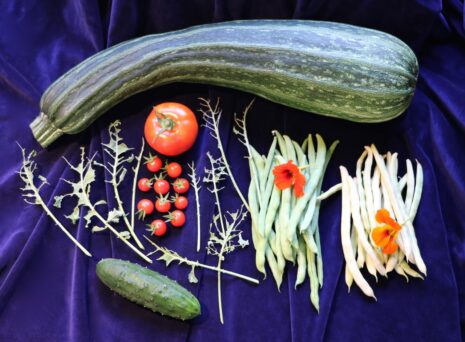Sex, Bugs and Lacy Leaves

Un texte de Andrea Conway
Paru dans le numéro Automne/Fall 2020
Publié le : 9 septembre 2020
Dernière mise à jour : 30 octobre 2020
Harvest season, time to celebrate bountiful crops in the garden. This year we decided to add a few raised beds allowing us to grow a bigger variety of vegetables. All we’d planted in our previous garden were beans, herbs and a couple of tomato plants. All summer we would patiently wait for the few tomatoes…
Harvest season, time to celebrate bountiful crops in the garden. This year we decided to add a few raised beds allowing us to grow a bigger variety of vegetables. All we’d planted in our previous garden were beans, herbs and a couple of tomato plants. All summer we would patiently wait for the few tomatoes to ripen. Finally, when they were nice and red, chipmunks would get there first taking a couple of bites out of each one leaving the rest of the tomato behind ready for the bugs to move in.
This year was different. We planted many more plants so there were enough to go around. I mentioned to my neighbour that I had planted a Lebanese zucchini plant. Somewhat distracted at the time, I did not retain everything she said except something about a male and female flower, pollination, and a Q-tip. Noticing a couple of flowers the next day and without further investigation, I trusted my instincts, observed the anatomy and dove in with my Q-tip. My husband, watching from the window, questioned what I was doing in the garden. I said: “I was performing sexual acts with my zucchini…p-l-a-n-t”. Realizing how it sounded, I quickly rephrased. “I was helping my zucchini plant flowers with their sexual relationship.” We ended up with a doozy of a 7 lb. zucchini. I’m now considering working as a horticultural sex therapist!
I explained to my husband that both sexed flowers have to be open at the same time, one needs to be pollinated by the other to produce worthy fruit. The flowers do not stay open for very long, it is all a question of availability and timing. Un-pollinated zucchinis are very small, go soft and rot. He shuttered at the descriptive visual. Obviously, the odds are not in your favour with one plant. Next year I plan to have several plants so they can mingle amongst themselves and let the bees do the dirty work.
Finally, we had enough for everyone…the hungry birds, worms, beetles and bugs in general! Needless to say, some crops were more successful than others. Our cherry tree full of flowers ended up as a tree full of pits. We ate what we could from our green “skeleton” kale, courtesy of the cabbage butterfly worm. We harvested a fair amount of red currants and some berries for our cereal despite their leaves being chewed into the finest lace thanks to the constantly copulating Japanese beetles. The garden also gave us bunches of beans, Swiss chard, lots of lettuce and yes, almost too many tomatoes. We’re now hoping they’ll ripen before the frost!
A big thank you to all our local farmers as I’ve had a mere taste of how challenging growing produce can be.
Andrea Conway— A transplant-surviving, Covid-isolated, tap dancing clown

